
Bands of hungry primeval men hunt gigantic prehistoric creatures in these fanciful Cup Noodle commercials from the early '90s. (Stop-motion animation by Kim Blanchette.)
[More here, including a mammoth, pterodactyl and giant warthog.]

Bands of hungry primeval men hunt gigantic prehistoric creatures in these fanciful Cup Noodle commercials from the early '90s. (Stop-motion animation by Kim Blanchette.)
[More here, including a mammoth, pterodactyl and giant warthog.]
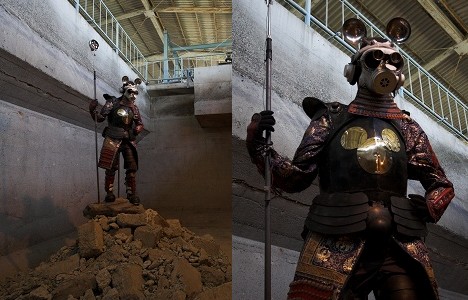
Mickey the Knight, a sculptural work by visionary neo-pop artist Yanobe Kenji, is a mouse-eared, gas-masked, fully-armored warrior who looks like a mutant samurai member of the Mickey Mouse Club.
According to Yanobe's notes, which were on display along with Mickey the Knight at a recent Yokosuka Museum of Art exhibit, he was invited to submit a Disney-themed piece for Disneyland's giant 50th anniversary celebration held in 2005. Known for work that explores issues like how to survive and have fun in post-apocalyptic settings, Yanobe drew inspiration from the legendary Mickey Mouse Gas Mask, an intriguing historical artifact whose background story reflects some of the themes found in Yanobe's work.
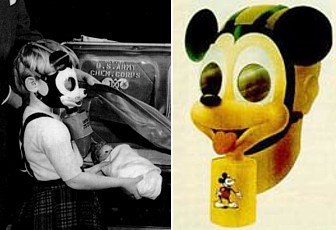 The Mickey Mouse Gas Mask was manufactured in 1942, at a time when segments of the American population, particularly those in Hawaii, feared a potential gas attack by the Japanese. With the permission of Walt Disney himself, 1,000 of the masks were produced for the US Army, who distributed them to civilians in the hope that the friendly, toy-like design would encourage children to carry them around and wear them for longer periods of time should an actual attack ever occur, thus improving their chances for survival. Apparently, this concept inspired Yanobe to create Mickey the Knight.
The Mickey Mouse Gas Mask was manufactured in 1942, at a time when segments of the American population, particularly those in Hawaii, feared a potential gas attack by the Japanese. With the permission of Walt Disney himself, 1,000 of the masks were produced for the US Army, who distributed them to civilians in the hope that the friendly, toy-like design would encourage children to carry them around and wear them for longer periods of time should an actual attack ever occur, thus improving their chances for survival. Apparently, this concept inspired Yanobe to create Mickey the Knight.
Unfortunately, however, Disney was not impressed with Yanobe's creation, and the big anniversary celebration passed without an invitation. Now, Mickey the Knight can be seen on occasion hanging out at museums and galleries. (The top photo shows Mickey the Knight at an installation in an old factory in Ibaraki prefecture, which was part of the Toride Art Project 2006.)
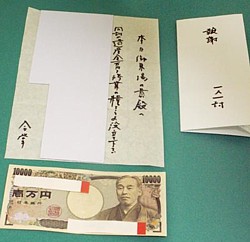 Over the past several months, small stacks of envelopes, each containing a 10,000 yen bill (about $85) and a handwritten letter, have been turning up in the restrooms at prefectural offices across Japan. On July 11, officials announced the mystery money has been found in 33 different restrooms in government offices located in 15 prefectures -- Hokkaido, Aomori, Miyagi, Akita, Niigata, Saitama, Chiba, Shizuoka, Tokyo, Osaka, Nara, Hyogo, Oita, Nagasaki and Miyazaki.
Over the past several months, small stacks of envelopes, each containing a 10,000 yen bill (about $85) and a handwritten letter, have been turning up in the restrooms at prefectural offices across Japan. On July 11, officials announced the mystery money has been found in 33 different restrooms in government offices located in 15 prefectures -- Hokkaido, Aomori, Miyagi, Akita, Niigata, Saitama, Chiba, Shizuoka, Tokyo, Osaka, Nara, Hyogo, Oita, Nagasaki and Miyazaki.
In every case where the money turns up, the 10,000 yen bills are each enclosed in separate envelopes with the words "payment" and "one envelope per person" written on them. The envelopes also include a handwritten message asking the finder to use the money to help pay for some sort of study or training.
In Tokyo, a stack of ten envelopes was found in the restroom on the first floor of the Tokyo city office on June 14. Elsewhere in the city, stacks of nine envelopes were found in the men's restrooms at both the Kita and Itabashi ward offices, and a stack of ten was found in a restroom at the Shinjuku ward office.
According to officials in Shizuoka prefecture, where 200,000 yen (about $1,700) was discovered in the restrooms at the city and prefectural offices, each of the 20 accompanying letters written on rice paper featured slight differences in handwriting, indicating a single benefactor wrote each letter by hand.
The first known mystery money appeared in Sendai on April 9, where a stack of six envelopes was found in the first-floor men's restroom of the city office.
All told, more than 2.8 million yen (more than $23,000) has been found in restrooms across Japan.
[Sources: Asahi, Yomiuri, Tokyo Shimbun]
 On the morning of July 10, police responding to an emergency call in the town of Miura, about 30 miles south of Tokyo, found a bound and gagged man lying apparently unconscious next to a forest road. The victim, a 22-year-old Leading Seaman stationed at the Japan Maritime Self-Defense Force base in Yokosuka, told police a man had attacked him, tied his hands, stuffed a towel in his mouth and dumped him alongside the wooded road.
On the morning of July 10, police responding to an emergency call in the town of Miura, about 30 miles south of Tokyo, found a bound and gagged man lying apparently unconscious next to a forest road. The victim, a 22-year-old Leading Seaman stationed at the Japan Maritime Self-Defense Force base in Yokosuka, told police a man had attacked him, tied his hands, stuffed a towel in his mouth and dumped him alongside the wooded road.
Suspecting the man had been mugged and kidnapped, the police launched an immediate investigation into the incident. However, as the police questioned the victim, their suspicions began to grow when they realized he had suffered no injuries, his clothing appeared tidy, his hands had been tied in front of his body (as opposed to behind his back), and his feet had not been bound. As the questioning became more pointed, the man finally broke down and confessed. "My subordinates at work don't listen to what I say," he said. "I hate going to work, so I staged the whole thing."
Police later learned that the Leading Seaman had arrived at Keikyu Miura Kaigan station on the last train the night before he was found, and that he had walked north from the station for about a mile until he found a wooded area. There, he stuffed a towel in his mouth, tied his hands, and lay down next to the road. Bound and gagged, he perhaps even napped in comfort amongst the trees, knowing he wouldn't have to face his unruly subordinates at work the next day.
The marine officer was later admitted to a hospital for minor dehydration, and police are waiting until he recovers before they resume their questioning. The man may face misdemeanor charges for filing a false police report because he did not immediately confess the identity of his kidnapper.
[Source: Chunichi]
These videos by Ne-o feature unique spatial-temporal visual tricks spiced with dark humor and slices of mundane-but-fantastic Tokyo scenery.
Futureshock -- "Late at Night": Music video with some great night scenery, featuring an unlikely cast of nocturnal characters doing a crazy body-popping dance.
Humanity: Man merges with machine in this Toyota CM for an automobile with a very human touch. This film won the 2006 Cannes Silver Lion.
Salaryman 6: A salaryman trapped in a routine, day-to-day existence loses his memory. The film is shot in ultra-widescreen format to capture the drama of the futuristic Tokyo cityscape, and while some of the cinematic beauty may shine through on your paltry YouTube window, this was clearly meant for the big screen.
B3: A weird trip through a deserted underground parking garage, created from still photos using 3D composting and morphing techniques.
[Link: Ne-o]
Photos of giant cement octopi posing as playground equipment in Japan...
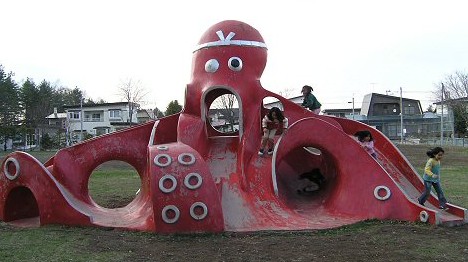
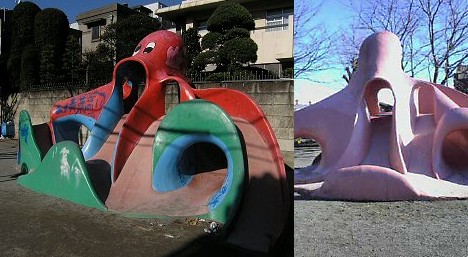
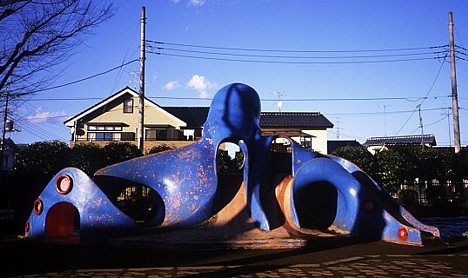
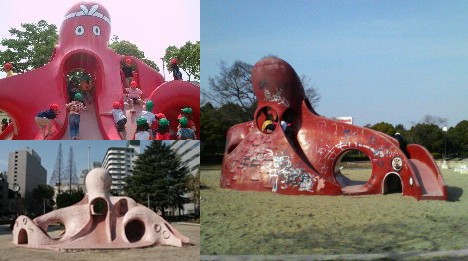
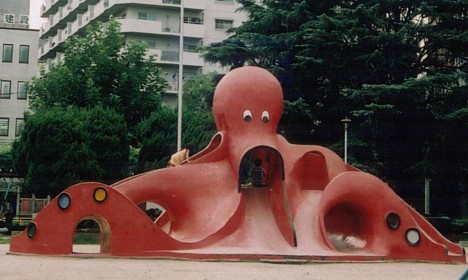
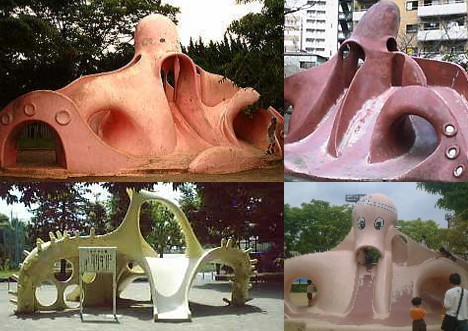
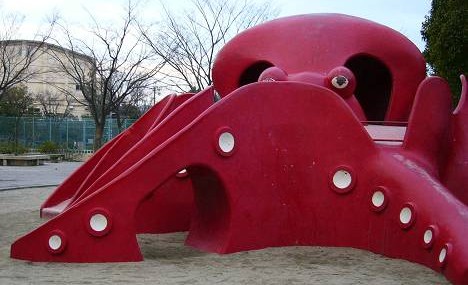
UPDATE: Here's a huge, wonderful photo gallery of octopus slides (Thanks, Alexander!). According to the site, there are no accurate records showing how many of these giant cement creatures exist in Japan, but they are believed to number in the hundreds. Many of these octopi, if not all, were constructed by Maeda Environmental Art Co., Ltd., who says each one has a unique design.
For more photos, check out this page by D-one, a photographer with an eye for the octopoid playscapes (the links that include pink text (??) are the ones you want to see). Also, a lot of the links on this page are to photos of octopus slides.
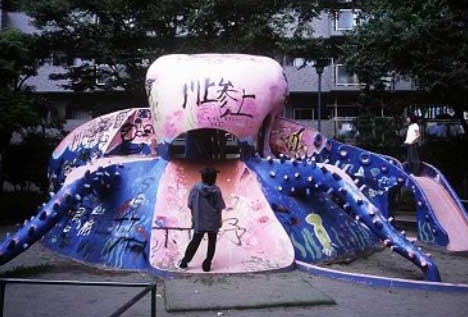
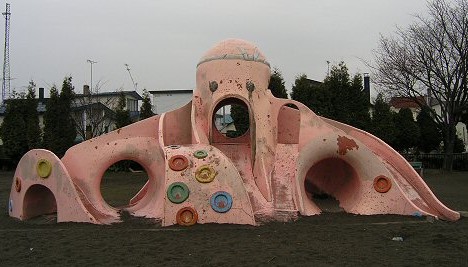
Looking to shed a few pounds? Check out this infomercial for Ega-chan's Boot Camp, a fan-made spoof on Billy's Boot Camp, the exercise DVD taking Japan by storm.
When not starring in mashup exercise videos, comedian Ega-chan (better known as Egashira 2:50) is busy shocking TV audiences with his obscene jokes and indecent exposure (although he does not appear on TV as frequently as he used to). The controversial Ega-chan was recognized as the comedian that Japanese people most love to hate in a poll conducted in 2005. He is usually seen wearing a pair of tights and no shirt -- the perfect outfit for a workout video host.
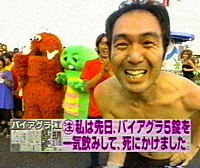 On several occasions, audiences outside Japan have had a chance to witness Ega-chan's shock tactics. In 1996, he was arrested by Turkish authorities for public indecency after getting naked, inserting a foreign object into his nether regions and doing a handstand as part of a guerrilla performance (for TV Tokyo) staged in front of a crowd of spectators at an oil wrestling tournament. In a less shocking but also entertaining incident, he was arrested in North Korea in 2003 for placing a Korean-language version of a "Nan de darou?" sticker (a gift from some Korean comedians he met at party) on his bus driver's chest. "Nan de darou?" -- which translates into English as "Why is it so?" -- was a Japanese phrase popularized in the early 2000s by an atrociously silly song by comedy duo Tetsu and Tomo, who happened to be travelling with Ega-chan in North Korea at the time. Apparently, "why is it so?" is a forbidden phrase in North Korea, so the sticker was seen by the authorities as a sign of dissidence. Ega-chan was arrested and detained for questioning.
On several occasions, audiences outside Japan have had a chance to witness Ega-chan's shock tactics. In 1996, he was arrested by Turkish authorities for public indecency after getting naked, inserting a foreign object into his nether regions and doing a handstand as part of a guerrilla performance (for TV Tokyo) staged in front of a crowd of spectators at an oil wrestling tournament. In a less shocking but also entertaining incident, he was arrested in North Korea in 2003 for placing a Korean-language version of a "Nan de darou?" sticker (a gift from some Korean comedians he met at party) on his bus driver's chest. "Nan de darou?" -- which translates into English as "Why is it so?" -- was a Japanese phrase popularized in the early 2000s by an atrociously silly song by comedy duo Tetsu and Tomo, who happened to be travelling with Ega-chan in North Korea at the time. Apparently, "why is it so?" is a forbidden phrase in North Korea, so the sticker was seen by the authorities as a sign of dissidence. Ega-chan was arrested and detained for questioning.
Trivia aside (thanks, Wikipedia Japan), Ega-chan's Boot Camp has the makings of an effective weight loss tool, mainly because Egashira is such an entertaining spaz. Some of his moves might be difficult to replicate, though.
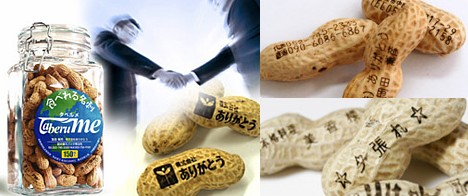
For people looking to liven up the formal rigamarole surrounding the exchange of business cards in Japan, Arigatou Co., Ltd., a company specializing in the sale of laser-etched food products, offers "Taberu Me" edible business cards printed on peanuts.
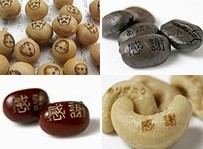 Taberu Me cards are created using Arigatou's high-grade CO2 laser engraver nicknamed "Shiawase-kun," which can etch up to 700 characters per second on hard organic materials like beans, nuts, rice and pasta and which has been optimized to print clean-looking logos, names and telephone numbers on the irregular surfaces of peanut shells.
Taberu Me cards are created using Arigatou's high-grade CO2 laser engraver nicknamed "Shiawase-kun," which can etch up to 700 characters per second on hard organic materials like beans, nuts, rice and pasta and which has been optimized to print clean-looking logos, names and telephone numbers on the irregular surfaces of peanut shells.
As for the product name, Taberu means "eat" and Me could either be an abbreviation of meishi ("business card") or "me" in English, in which case Taberu Me would be saying "Eat me" -- a message you probably don't want to convey to your new business partner at the first meeting. Regardless, a set of 150 Taberu Me cards costs 5,800 yen (around $50), which is mere peanuts considering the lasting impression you will make on your new counterparts.
[Link: Taberu Me via Gizmodo Japan]
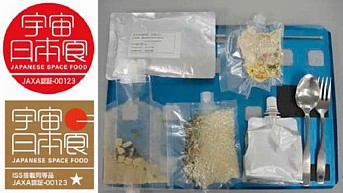 A new menu is in the works for hungry cosmonauts with a taste for Japanese cuisine. On June 27, in a move to expand the menu aboard the International Space Station, the Japan Aerospace Exploration Agency (JAXA) certified 29 Japanese food products from 12 manufacturers as official Japanese space food.
A new menu is in the works for hungry cosmonauts with a taste for Japanese cuisine. On June 27, in a move to expand the menu aboard the International Space Station, the Japan Aerospace Exploration Agency (JAXA) certified 29 Japanese food products from 12 manufacturers as official Japanese space food.
All items on the Japanese space menu -- which includes instant ramen, curry, onigiri (rice balls) and powdered green tea -- satisfy the International Space Station's stringent standards requiring packaged foods to withstand changes in air pressure and temperature and survive one year in storage under ordinary earthly temperatures. To meet these requirements, the food products are packed in special tubes. The foods also satisfy the preparation time requirement, which calls for food to be ready to eat in less than one hour after adding heat or water.
In addition, much of the space food has been redesigned to prevent it from scattering in zero-g. The ramen, for example, features a thick broth and noodles that are clumped together in bite-sized pieces. Extra flavoring has also been added because food tends to taste bland in zero-g.
Once the ISS menu is expanded to include the Japanese space food, astronauts aboard the space station will be able to eat it as they wish. Japanese astronaut Koichi Wakata, who is scheduled for a long-term stay aboard the International Space Station beginning in the fall of 2008, will undoubtedly appreciate the new fare.
Here is a complete list of the officially recognized Japanese space food products and the companies that produce them:
- Ajinomoto: Egg soup
- Onishi Foods: White rice, rice with red azuki beans, rice with red azuki beans and wild greens, salmon onigiri
- Kagome: Tomato ketchup, vegetable sauce, vegetable jelly drink (tomato/carrot)
- Kewpie: Mayonnaise, rice porridge
- Nissin: Soy sauce ramen, seafood ramen, curry ramen
- House Foods: Curry (beef/pork/chicken)
- Maruha: Mackerel in miso sauce, sardines in tomato sauce, kabayaki saury (broiled with sweet soy sauce)
- Mitsui Norin: Powdered green tea, powdered oolong tea
- Meiji: Functional drink (amino jelly)
- Yamazaki Baking: Azuki bean yokan (jelly), chestnut yokan
- Yamazaki-Nabisco: Kuroame (brown sugar candy), mint candy
- Riken Vitamin: Wakame (seaweed) soup, clear soup
[Sources: Yomiuri, JAXA press release]